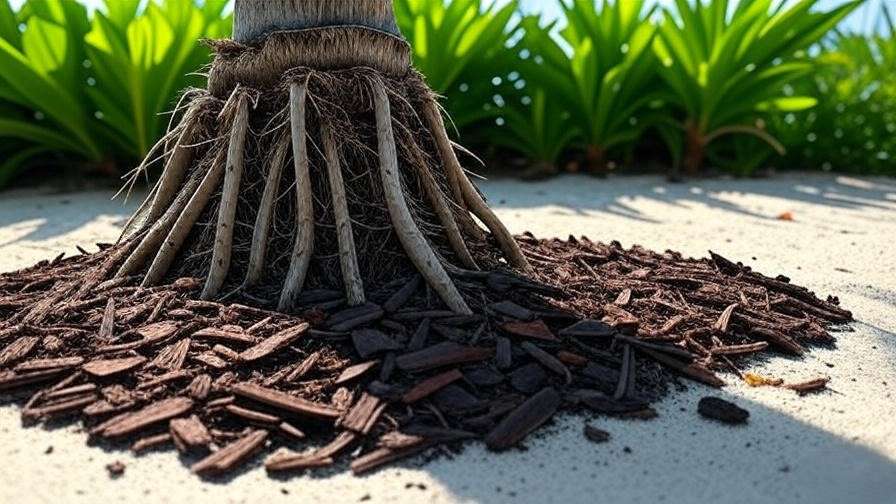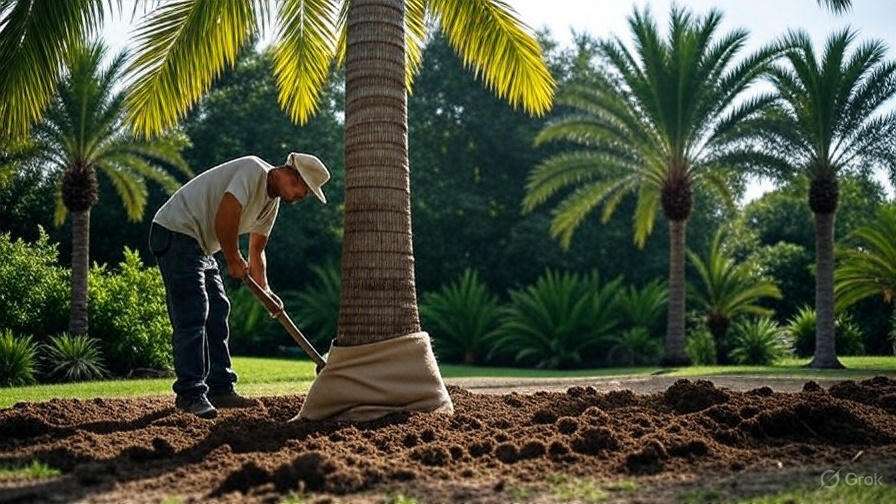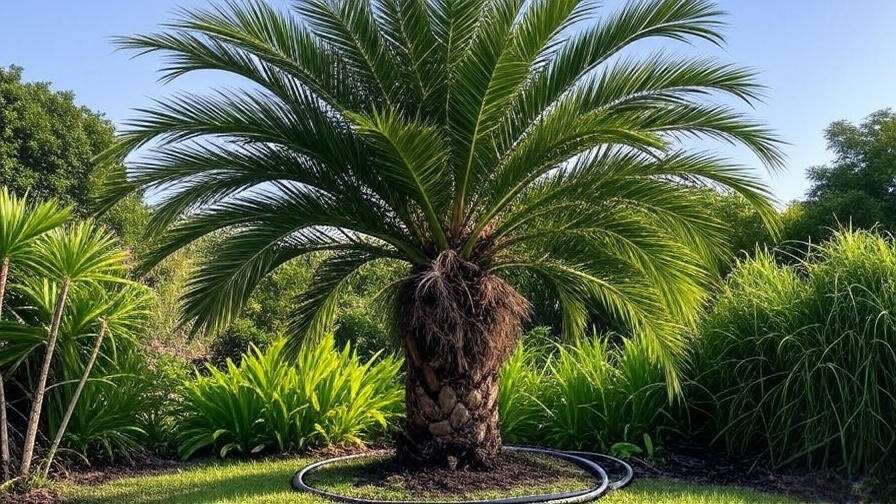Imagine stepping into your backyard, where towering palm trees sway gently, their vibrant fronds casting dappled shade over a lush, tropical oasis. Yet, beneath this beauty lies a hidden challenge: the roots on palm trees, which can make or break your landscape’s health and harmony. Whether you’re a homeowner dreaming of a resort-like yard or a landscaper nurturing a client’s vision, understanding and managing palm tree roots is key to ensuring these iconic trees thrive. Poor root care can lead to cracked pavements, unhealthy trees, or failed transplants, but with the right knowledge, you can avoid these pitfalls. In this comprehensive guide, we’ll share seven essential tips—backed by arborist expertise and horticultural science—to help you nurture healthy roots on palm trees for a stunning, sustainable landscape. 🌞
Section 1: Understanding the Unique Root System of Palm Trees 🌱
What Makes Palm Tree Roots Different?
Unlike the deep taproots of oaks or maples, palm trees boast a fibrous root system that sets them apart in the plant world. These roots, often shallow and spreading, form a dense network just below the soil surface, typically extending 12-36 inches deep and outward as far as the canopy or beyond. This unique structure allows palms to anchor in sandy, loose soils common in tropical regions, but it also poses challenges for urban landscapes.
For example, consider the Coconut Palm (Cocos nucifera), whose roots spread widely to absorb water in coastal environments, versus an Oak tree, which relies on a deep taproot for stability. This difference means palm roots are more likely to surface, impacting lawns or sidewalks, yet they’re less invasive than commonly feared. Understanding this anatomy is the first step to effective care.
Expert Insight: Dr. Maria Gonzalez, a certified arborist with 15 years of experience in tropical horticulture, notes, “Palm roots are remarkably efficient but sensitive. Their fibrous nature demands careful handling to maintain tree vigor and prevent environmental damage.”
Common Challenges with Roots on Palm Trees
Surface Roots and Landscape Issues
The shallow roots of palms, like those of the Royal Palm (Roystonea regia), often become exposed, creating uneven surfaces that can damage lawnmowers, trip pedestrians, or crack nearby pavement. For instance, a homeowner in Miami discovered their driveway lifting due to the spreading roots of a nearby Canary Island Date Palm (Phoenix canariensis). These surface roots, while not deeply invasive, can disrupt hardscapes if not managed proactively.
Transplanting and Root Stress
Transplanting palms is notoriously tricky due to their sensitive root systems. Cutting too many roots or failing to preserve the root ball can lead to transplant shock, stunted growth, or even tree death. A common mistake is digging too narrowly, severing critical fibrous roots. Tip: Always excavate a wide root ball—ideally 12-18 inches beyond the trunk’s base—to ensure the tree’s survival.
Section 2: 7 Essential Tips for Managing and Caring for Palm Tree Roots 🌞
Tip 1 – Choose the Right Planting Location
Assessing Soil and Space
Selecting an ideal planting site is crucial for healthy palm roots. Palms thrive in well-draining soils, such as sandy loam, which prevent waterlogging—a common cause of root rot. Ensure the location offers enough space for roots to spread without encroaching on structures. For larger species like the Royal Palm, maintain at least 8-10 feet of clearance from foundations, sidewalks, or pipes.
Tip: Test soil drainage by digging a 12-inch hole, filling it with water, and observing how quickly it drains. If it takes longer than an hour, amend the soil with organic matter or choose a better-drained site.
Avoiding Future Root Conflicts
Strategic planting prevents future headaches. For example, planting a Date Palm (Phoenix dactylifera) too close to a pool can lead to root intrusion into plumbing systems. Map out your landscape, considering the mature size of the palm’s canopy and root spread, to avoid costly repairs. A well-planned site ensures both aesthetic appeal and structural safety.
Tip 2 – Water Wisely to Support Root Health
Proper Irrigation Techniques
Palm roots need consistent but not excessive moisture to thrive. Deep, infrequent watering encourages roots to grow downward, enhancing stability and nutrient uptake. Use a soaker hose or drip irrigation to target the root zone—typically the area beneath the canopy—delivering water slowly to penetrate 12-18 inches deep.
Tip: For a newly planted palm, water daily for the first two weeks, then reduce to 2-3 times per week, adjusting based on rainfall and climate. In arid regions, a weekly deep soak is ideal.
Avoiding Overwatering
Overwatering is a leading cause of root rot, especially in clay-heavy soils. Symptoms include yellowing fronds or a mushy trunk base. A 2023 study by the University of Florida’s Institute of Food and Agricultural Sciences found that overwatered palms, like the Sabal Palm (Sabal palmetto), showed a 40% higher incidence of fungal root infections. Monitor soil moisture with a simple probe to keep roots healthy.
Tip 3 – Mulch for Root Protection and Soil Health
Benefits of Mulching
Mulching is a game-changer for palm root care. A 2-4 inch layer of organic mulch, like bark or compost, retains soil moisture, regulates temperature, and reduces root exposure. It also suppresses weeds that compete with roots for nutrients. Importantly, mulch enhances the tropical aesthetic, making your landscape pop.
Tip: Keep mulch 2-3 inches away from the trunk to prevent rot, creating a “donut” shape around the base. Refresh the mulch annually to maintain its benefits.

Choosing the Right Mulch
Opt for organic materials like pine bark, wood chips, or shredded leaves over synthetic options like rubber mulch, which can retain heat and harm roots. For example, a landscaper in Southern California transformed a client’s yard by using pine bark mulch around Pygmy Date Palms (Phoenix roebelenii), boosting root health and visual appeal.
Tip 4 – Fertilize Strategically for Strong Roots
Nutrient Needs for Palm Roots
Palm roots require specific nutrients, particularly potassium and magnesium, to support growth and resilience. A deficiency in these can lead to weak roots and yellowing fronds. Use a slow-release, palm-specific fertilizer with a 3-1-3 NPK ratio (e.g., 12-4-12) plus micronutrients like manganese and iron.
Tip: Apply fertilizer evenly within the root zone, extending to the canopy’s edge, to ensure all roots benefit. Avoid piling fertilizer near the trunk, which can cause burn.
Timing and Application
Fertilize in spring and summer when palms are actively growing. Two to three applications per year are typically sufficient, following package instructions for dosage. Over-fertilizing can damage roots, so err on the side of caution. For instance, a homeowner in Texas revived a struggling Queen Palm (Syagrus romanzoffiana) by switching to a balanced palm fertilizer applied biannually.
Tip 5 – Monitor and Manage Surface Roots
Safely Handling Exposed Roots
Surface roots are a common issue with palms, particularly in compact urban settings. These exposed roots can create tripping hazards or damage landscaping equipment. To manage them, avoid cutting or removing roots, as this can destabilize the tree or invite disease. Instead, cover exposed roots with a thin layer of soil or mulch to protect them while maintaining aesthetics. For high-traffic areas, consider installing permeable pavers, which allow roots to breathe and grow while providing a stable surface.
Tip: If roots are lifting walkways, use a flexible material like decomposed granite to create a smooth transition over the roots, preserving both tree health and accessibility. For example, a Florida homeowner successfully integrated permeable pavers around a Bismarck Palm (Bismarckia nobilis) to maintain a safe, attractive pathway.

When to Consult an Arborist
For extensive root exposure or structural concerns, such as roots encroaching on foundations, consult a certified arborist. They can assess the tree’s health and recommend solutions like root barriers or relocation. Expert Insight: John Carter, an ISA-certified arborist, advises, “Never underestimate the impact of surface roots. Early intervention by a professional can save both your palm and your property.”
Tip 6 – Protect Roots During Transplanting
Best Practices for Transplanting Palms
Transplanting palms requires careful attention to their fibrous root system to minimize shock. Start by pre-watering the tree a day before digging to hydrate the roots. Excavate a wide root ball—ideally 12-18 inches beyond the trunk’s base for small palms and up to 24 inches for larger ones like the Mexican Fan Palm (Washingtonia robusta). Keep the root ball intact by wrapping it in burlap, and replant immediately to reduce exposure.
Tip: Use a sharp spade to make clean cuts, preserving as many fine roots as possible. Water the new site thoroughly before placing the palm to ensure a moist environment for root establishment.

Post-Transplant Root Care
After transplanting, water daily for the first two weeks, then taper to 2-3 times weekly. Stake the palm lightly to prevent wind toppling, but avoid tight ties that could damage the trunk. Monitor for signs of transplant shock, such as drooping fronds or slowed growth, and apply a root-stimulating fertilizer to encourage recovery. A case study from a California nursery showed that proper post-transplant care increased survival rates for transplanted Sago Palms (Cycas revoluta) by 85%.
Tip 7 – Prevent and Treat Root-Related Diseases
Identifying Root Diseases
Healthy roots are firm and white, but diseases like root rot or fungal infections can turn them brown, mushy, or foul-smelling. Common culprits include Phytophthora fungi, which thrive in waterlogged soils, and Ganoderma butt rot, which affects the lower trunk and roots. Symptoms in the canopy, like wilting or yellowing fronds, often signal root issues. For instance, a homeowner in Arizona noticed their Sago Palm’s fronds browning, later discovering Ganoderma root rot through a professional diagnosis.
Tip: Regularly inspect the base of your palm for soft spots or fungal conks (shelf-like growths), which indicate serious root disease.

Treatment and Prevention
Prevent root diseases by ensuring proper drainage and avoiding overwatering. If root rot is suspected, improve soil aeration and reduce watering immediately. In severe cases, apply a fungicide labeled for palms, following guidelines from a local extension service. Removing dead fronds promptly reduces fungal spore spread. Expert Insight: A 2024 study by the University of Hawaii found that improving drainage around infected palms reduced Phytophthora spread by 60%. Regular inspections and early intervention are key to saving affected trees.
Section 3: Practical Applications and Real-World Examples 🌴
Designing a Palm-Friendly Landscape
Integrating Palms into Your Garden
A well-designed landscape accommodates palm roots while enhancing visual appeal. Pair palms with low-root groundcovers like Liriope or Mondo Grass, which don’t compete for nutrients. For example, combining Pygmy Date Palms (Phoenix roebelenii) with Liriope creates a lush, low-maintenance border that highlights the palm’s elegance. Space palms strategically to allow root spread, and incorporate raised beds or berms to improve drainage in heavy soils.
Tip: Use native plants as companions to reduce water and maintenance needs, creating a sustainable, tropical vibe.

Case Study: A Successful Palm Landscape
Consider the case of Lisa, a homeowner in South Florida, who transformed her yard into a tropical paradise. Initially, her Sabal Palms suffered from exposed roots and poor growth due to compacted soil. By consulting an arborist, she implemented a plan: amending the soil with compost, adding a 3-inch mulch layer, and installing permeable walkways. Within a year, her palms showed vibrant fronds, no structural damage occurred, and her landscape became the neighborhood’s envy. This success underscores the power of proactive root care.
Section 4: FAQs About Roots on Palm Trees ❓
Q1: Can palm tree roots damage my foundation?
A: While palm roots are not deeply invasive, their lateral spread can lift pavements or encroach on shallow pipes. Prevent damage by planting palms at least 8-10 feet from structures and using root barriers if needed.
Q2: How deep do palm tree roots grow?
A: Palm roots are shallow, typically extending 12-36 inches deep. Their fibrous nature means they spread horizontally, often matching or exceeding the canopy’s width.
Q3: How often should I water my palm tree to support its roots?
A: Water newly planted palms daily for two weeks, then 2-3 times weekly, adjusting for rainfall. Established palms need deep watering 1-2 times per week in most climates.
Q4: What should I do if my palm’s roots are exposed?
A: Cover exposed roots with soil or mulch, or use permeable pavers for high-traffic areas. Avoid cutting roots, and consult an arborist for significant exposure.
Q5: Are palm tree roots invasive?
A: Palm roots are not truly invasive, as they don’t penetrate deeply like some trees. However, their lateral spread can disrupt surfaces if not managed properly.
Section 5: Conclusion and Call to Action 🌞
Nurturing the roots on palm trees is the foundation of a thriving, tropical landscape. By choosing the right planting site, watering wisely, mulching effectively, fertilizing strategically, managing surface roots, protecting during transplants, and preventing diseases, you can ensure your palms flourish for years. These seven essential tips, grounded in expert horticultural practices and real-world success, empower you to avoid common pitfalls and create a stunning, sustainable yard.
Ready to transform your landscape? Start applying these tips today and watch your palms thrive. Share your palm care journey in the comments below, subscribe for more plant care insights, or contact a local arborist for tailored advice. Your tropical oasis is just a few root-smart steps away! 🌴













